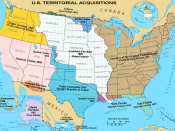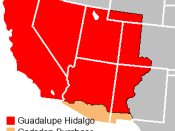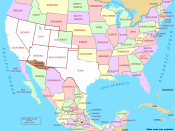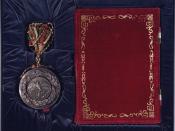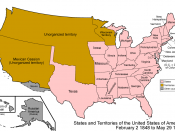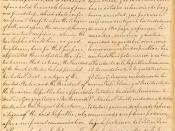Manifest Destiny was a movement which inspired many Americans. It is believed that Manifest Destiny's systematic body of concepts and beliefs empowered American life and American cultures. This movement had many ups and downs and even some religious influences. Manifest Destiny was also looked at from many view points and opinions.
The idea of Manifest Destiny is as old as America itself. The philosophy sailed with Christopher Columbus across the Atlantic. It resides in the spirits of the Jamestown colonist and it landed at Plymouth Rock with the Pilgrims. It also traveled with the fire and brimstone preachers during the Great Awakening and built the first national road. Throughout history there are numerous examples of Manifest Destiny.
Although the movement was named in 1845, the philosophy behind Manifest Destiny always existed through American History. One example is Andrew Jackson, who in 1818, was taking a broad interpretation of vague instructions from President Monroe, and led military forces into the Floridas during the Florida crisis.
As a result he punished the Seminal Indians for taking up arms with the Spanish. He destroyed Spanish Forces, and captured several cities and forts in an orderly yet careless and ruthless fashion.
The reason why Americans where in Florida in the first place, is yet another example of Manifest Destiny. The people of the deep south, wanting more fertile land, exercise what they consider to be their right. The planter class, without any political approval or permission, just took over and started settling and planting the Florida Pg. 2 territories. This move was an example of the arrogance that the Americans had towards expansion. Americans believed that they had a right to any land they wanted. First used in 1845, the term Manifest Destiny conveyed the idea that the rightful destiny of the United States included imperialistic expansions.
By the 1840's, expansion was at the highest. The Santa Fe Trail went from Independence to the Old Spanish Trail, which went into Los Angeles. The Oxbow Route headed from Missouri to California. Others headed out on the Oregon Trail to the Pacific Northwest. In 1845, approximately 5,000 people traveled the Oregon Trail to Oregon's Willamette Valley. The Oregon Trail was the longest of the pioneer trail that went West. It traversed more than 2,000 miles' through trough prairie, desert, and rugged mountain land from Independence, Missouri to the Northwest.
Another result or example of Manifest Destiny was the Gadsden Purchase. The war, for Mexico, which lost 50,000 men and nearly half its land marked as an ugly milestone in its relations with the United States. The American's victory came at the cost of about 13,000 men. Of these, nearly 2,000 died in battle from wounds and more than 11,000 perished from disease, such as yellow fever. However the amount of the land gained by the United States was amazing. It caused major growth in U.S. territory, approximately one-third.
The Treaty of Guadalupe Hidalgo was signed by the U.S. and Mexico on February 2, 1848. Because of the agreement of Mexico to the Rio Grande border for Texas and to the ceding of New Mexico and California territory to the U.S. the U.S. in turn agreed to pay $15million for the Mexican cession, which include present day Pg. 3 California, Nevada, New Mexico, Utah, most of Arizona, and parts of Colorado and Wyoming. The treaty guaranteed Mexicans freedom of religion, protection of property, bilingual elections and open borders. Five years later, in 1853, President Franklin Pierce would authorize his emissary James Gadsden to pay Mexico an additional $ 10 million for another piece of territory south of the Gila River. Along with the settlement of Oregon and the Treaty of Guadalupe Hidalgo, the Gadsden Purchase established the current borders of the lower 48 states.
James Marshall, in January 1848, was an American Carpenter working on John Sutter's property in California Sierra Nevadas when he discovered gold. Work spread like a wild fire. Soon after the word spreadpeople came from all over the world panning for gold. This became such a problem that eventually because of the lack of staff and readers, San Francisco's newspaper, the Californian , was suspending it's publication. As gold fever traveled eastward, overland migration to California greatly increased. Population went from 400 in 1848 to 44,000 in 1850. The prospectors who flocked to California in 1849 in the gold rush, were people from Asia, South America, and Europe. But by 1849, California's population exceeded 100,000, including Mexicans, free African American miners, and slaves.
Finally, as a result a constitutional convention in 1849 drew up a state constitution that outlawed slavery. California's application for statehood provoked fiery protest in Congress and became just one more sore point between irate Northerners and Southerners, each with the mind-set and wish of winning the sectional argument over slavery.
